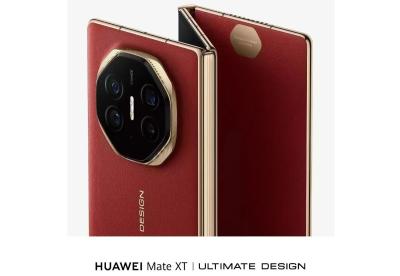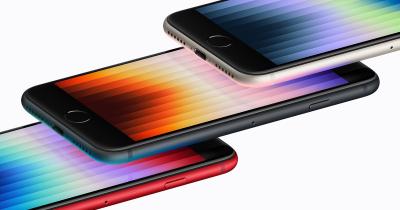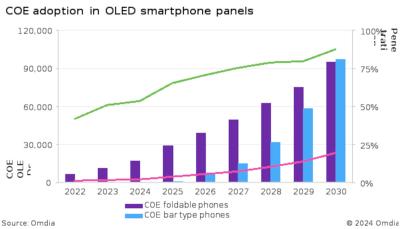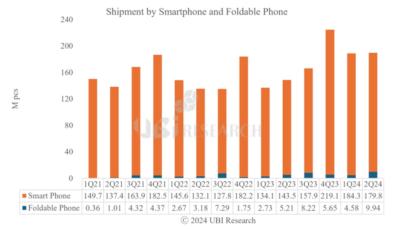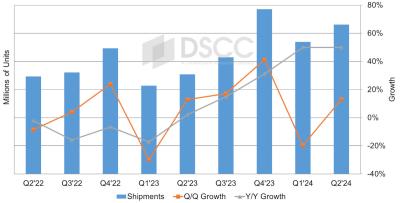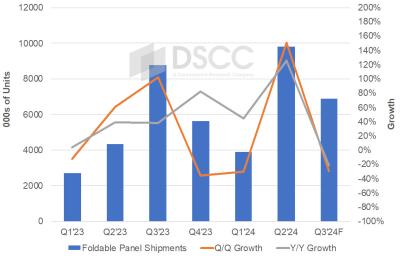OLED Smartphones - introduction and industry news - Page 2
Apple announces its 2024 iPhone 16 series, and the new Apple Watch Series 10, all with AMOLED displays
Yesterday Apple announced its 2024 iPhone 16 series, and its latest smartwatch devices - all based on OLED displays. We'll start with the the iPhone 16 that offers a 6.1" 2,000 nits (HBM) 1179x2556 Super Retina XDR LTPS AMOLED, while the iPhone 16 Plus offers a larger 6.7" 1290x2796 display. Both phones are based on Apple's latest 3nm A18 chipset offering improved performance and AI support.
The iPhone 16 Pro has a more advanced 6.3" 120Hz 2,000 nits (HBM) 1206x2622 LTPO Super Retina XDR OLED. The 16 Pro Max offers a larger 6.9" 1320x2868 AMOLED. These new phones are based on Apple's 3 nm A18 Pro chip, offer a "huge leap in battery life", support Apple Intelligence and feature new a main camera.
Huawei officially launches its Mate XT tri-folding OLED smartphone
Huawei officially announces the world's first tri-folding OLED smartphone, the Mate XT. The phone and its specifications will be unveiled on September 10, and will ship on September 20.
Huawei allows people to reserve their Mate XT phone, and already over 1.25 million people reserved it.
Reports say Apple to adopt an OLED display 2025 iPhone SE 4, start to order panels from LG Display and BOE
According to reports from Japan, Apple decided to adopt a 6.1" AMOLED display for its upcoming iPhone SE 4 smartphone, which will mean that all of the company's smartphone products will be based on OLED displays.
We actually reported this in March 2024, and back then it was suggested that Apple's target price was $25 for the OLED display - which was too low for Samsung Display that decided not to continue with its discussions with Apple. Back then it was estimate that BOE will supply the majority of the displays, and some orders will go to Tianma. According to the new report, the second supplier is actually LG Display.
Omdia forecasts fast growth in the adoption of COE technology for smartphone AMOLEDs, mainly foldable ones
Omdia says that Color-Filter on Encapsulation (COE) will grow to be the dominant technology in foldable OLED smartphone panels, and will replace the currently-used circular polarizers. COE adoption will grow at a 33% CAGR between 2024-2030, and by 2030 almost 90% of foldable smartphones will use COE technology, and almost 20% of all smartphone OLED panels.
The adoption of COE in OLEDs increases the panel effective brightness, which means that the display consumes less power compared to a polarizer OLED (same brightness) and also lasts longer. The color gamut is also improved. On the other hand, COE OLEDs suffer from higher reflectivity compared to polarizer OLEDs.
Tecno shows a tri-folding AMOLED smartphone concept
China-based smartphone maker Tecno has unveiled a new concept device, called the Phantom Ultimate 2, that sports a tri-folding OLED display.
The device is actually a working prototype, that when fully opened has a 10-inch 1620x2880 LTPO AMOLED display. When fully closed, the display is 6.48" in size. The company says it has developed a unique hinge design that enables the whole phone to be only 11 mm thick when fully closed. Tecno tested the device and the hinge and it lasts for over 300,000 folding cycles.
UBI Research: foldable OLED smartphone panel shipments reached 9.9 million in Q2 2024
UBI Research says that shipments of foldable OLED smartphone panels more than doubled in Q2 2024 (compared to the first quarter), reaching 9.94 million units. Foldable OLED smartphone panels accounted for 5.2% of the total OLED smartphone display market.
UBI expects foldable OLED panel shipments to continue growing in the second half of 2024, and sees total 2024 shipments exceeding 40 million. By 2028, the company expects foldable OLED panels to reach an almost 10% out of the entire OLED smartphone market.
DSCC: OLED panel shipments jumps 50% in Q2 2024
According to DSCC, OLED panel shipments increased 50% in the second quarter of 2024, compared to the second quarter of 2023. Compared to the previous quarter, shipments increased 13%.
DSCC says that OLED tablet shipments increased 356% in the quarter compared to last year (led by Apple's adoption of AMOLEDs in its iPad Pro devices). OLED smartphone spanel shipments also 49%, while OLED TV panel shipments increased 30% from 2023.
DSCC: Almost 10 million foldable OLED panels shipped in Q2 2024, a new record high
DSCC says that shipments of foldable OLED panels reached a record high in the second quarter of 2024 at 9.8 million units - 126% higher than Q2 2023 (and 151% higher than the previous quarter). DSCC believes this will be the peak quarter in 2024, as the demand was fueled by the launch of Samsung's latest foldables, the Galaxy Z Flip 6 and Z Fold 6.
Samsung holds an almost 50% market share in foldable smartphone panels orders, followed by Huawei at 29%. Timing is relevant, as high demand follows new model shipping dates. DSCC estimates that clamshell devices have a 63% market share out of the total foldable smartphone market, with the rest taken up by in-folding devices.
Google launches three new smartphones, a foldable phone and a new smartwatch all powered by AMOLED displays
Google announced five new devices, all powered by AMOLED displays. We'll start with the Pixel 9 smartphone series, with the plain Pixel 9 offers a 6.3" 120Hz 2,700 nits (peak) 1080x2424 AMOLED display, a Google Tensor G4 chipset, 12GB of RAM and 256 GB of storage. The Pixel 9 Pro offers a 6.3" 3,000 nits (peak) 120Hz 1280x2856 LTPO AMOLED, and up to 16 GB of RAM and 1 TB of storage. The Pixel 9 Pro XL offers a similar but larger display - 6.8" 1344x2992 LTPO AMOLED.
Google's Pixel 9 Pro Fold smartphone is based on a 8" 120Hz 2,700 nits (peak) 2076x2152 foldable LTPO AMOLED display, and an external 6.3" 120Hz 1080x2424 AMOLED. The Pixel 9 Pro Fold is powered by a Google Tensor G4 chipset, and offers up to 16GB of RAM and up to 512GB of storage.
Huawei's Chairman is using a tri-folding smartphone, should we expect a launch soon?
Back in February we posted about rumors that suggest Huawei is planning to release the industry's first smartphone that sports a tri-foldable OLED display. When fully open, the device will sport a 10" display, which means it will double as a full tablet and a smartphone.
Now we have seen a photo of Huawei's Chairman that uses such a smartphone on a flight. This could mean that Huawei is getting ready to officially launch such a phone.
Pagination
- Previous page
- Page 2
- Next page



